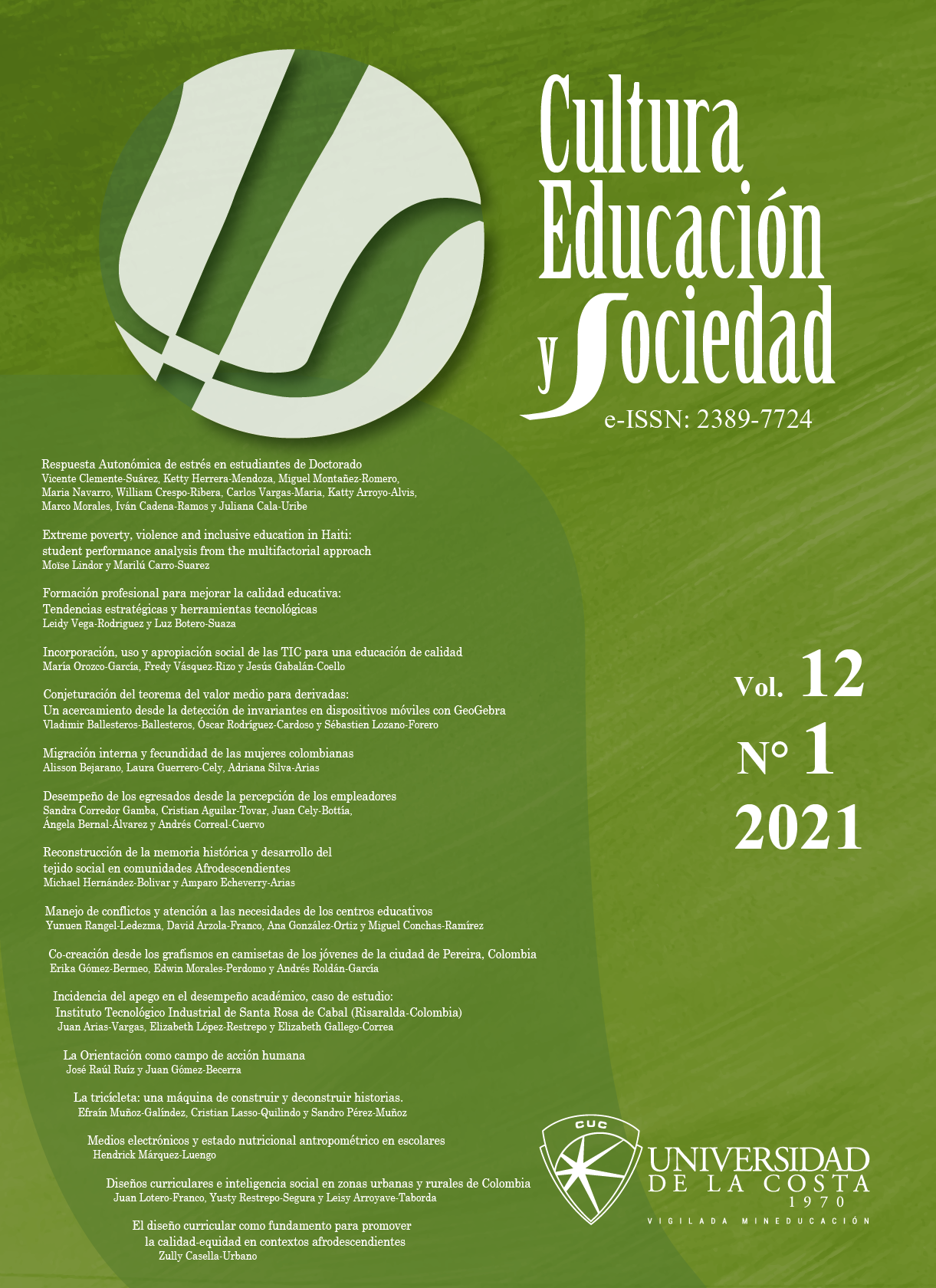Co-creation from the graphics on T-shirts of the youth of the city of Pereira, Colombia
DOI:
https://doi.org/10.17981/cultedusoc.12.1.2021.10Keywords:
Visual meanings, Graphics, Aesthetics, T- shirt print, Collaborative creationsAbstract
This article shows a particular interest in the t-shirt, a garment assumed as a communication device. The objective is to recognize the sociocultural and aesthetic meanings of the graphics revealed on the t-shirts of young people from the city of Pereira (Risaralda, Colombia), derived from the graphic influences to which they are exposed. To carry out this process, the qualitative approach is used, through an ethnographic approach for the consolidation of profiles that reflect the meanings of the group represented. The results obtained indicated four typologies: 1) the communicative use by commercial brands as a priority, 2) the preference from pregnancy to the composition of the form, 3) the use based on musical expressions, and 4) the use from political representations. In conclusion, the meanings of the graphics of the t-shirts are related to the communicative interests of the context in which they are developed, however, the uses of these garments are not only influenced by external factors of consumption, but also by the need to expose a social, political or cultural reality. The research-creation exercises acquire methodological relevance, both in the visual work and in the creative process to contribute to the transformative and communicative experienceDownloads
References
Arcangel. (2018). Arcangel + Bad Bunny - Original. [Official Video]. [Video de youtube]. Disponible en https://youtu.be/zkfyNvdMyYI?t=96
Aristóteles. (1873). La política. Madrid: FV Éditions.
Bourdieu, P. (2006). La Distinción, criterios y bases sociales del gusto. Madrid: Taurus.
Cardi B. (2018). Cardi B, Bad Bunny & J Balvin - I Like It [Official Music Video]. [Video de youtube]. Disponible en https://youtu.be/xTlNMmZKwpA?t=98
Carballo, P. (2011). Claves para entender las nuevas sensibilidades: Estudios sobre producciones culturales juveniles en Costa Rica. Revista latinoamericana de ciencias sociales, niñez y juventud, 7 (2), 1331–1347. Recuperado de http://biblioteca.clacso.edu.ar/Colombia/alianza-cinde-umz/20131127114206/art.PriscillaCarballo.pdf
Entwistle, J. (2002). El cuerpo y la moda Una visión sociológica. Barcelona: Paidós.
Glover, H. (2017). De la hoja de parra al bikini: la moda como soporte de comunicación social. [Tesis doctoral]. Universidad Complutense de Madrid, Madrid, España. Disponible en https://eprints.ucm.es/41612/
Goffman, E. (1959). La presentación de la persona en la vida cotidiana. Buenos Aires: Amorrortu editores.
Hernández, R. (2006). Argumentos para una metodología de dato visual. Cinta de Moebio, (26), 196–206. Disponible en https://www.moebio.uchile.cl/26/hernandez.html
Iglesias, J. (2015). El papel de las marcas de moda en la construcción de la identidad personal. [Tesis Doctoral]. Universitat Ramon Llull, Catalunya, España. Recuperado de https://www.tdx.cat/bitstream/handle/10803/369847/Tesi_Jordi_Iglesias.pdf?sequence=1&isAllowed=y
Leroi-Gourhan, A. (1971). El gesto y la palabra. Caracas: Ediciones de la Biblioteca.
Lipovetsky, G. (1990). El imperio de lo efímero. La moda y su destino en las sociedades modernas. Barcelona: Anagrama.
Lozano, M. C. y Alvarado, S. V. (2011). Juicios, discursos y acción política en grupos de jóvenes estudiantes universitarios de Bogotá. Revista Latinoamericana de Ciencias Sociales, Niñez y Juventud, 1(9), 101–113. Disponible en http://revistaumanizales.cinde.org.co/rlcsnj/index.php/Revista-Latinoamericana/article/view/346
Mandoki, K. (2006). Prosaica II: Prácticas estéticas e identidades sociales. México D.F.: Siglo XXI.
Migliaccio, M. (2013). Fundamentos antropológicos de la moda: Magnanimidad y Elegancia. [Tesis doctoral]. Universidad de Navarra, Pamplona, España. Disponible en https://dadun.unav.edu/handle/10171/29186
Muller, J. (2008). 100 clásicos del cine. Madrid: Taschen
Onofre-Chaves, D. (2017). La investigación en estilos de vida en psicología de consumidor. Cultura, Educación y Sociedad, 8(1), 51–70. http://dx.doi.org/10.17981/cultedusoc.8.1.2017.04
Sanders, E.-N. & Stappers, P. J. (2008). Co-creation and the new landscapes of design. Co-design, 4(1), 5–18. https://doi.org/10.1080/15710880701875068
Sanjurjo, B. (2001). La serigrafía como medio de expresión artística: (posibilidades técnicas). [Tesis doctoral]. Universidad complutense de Madrid, Madrid, España. Disponible en https://eprints.ucm.es/1720/
Santaella, M. (2006). La evaluación de la creatividad. Sapiens, 7(2), 89–106. Disponible en http://ve.scielo.org/scielo.php?script=sci_arttext&pid=S1317-58152006000200007&lng=es&tlng=es
Trindade, E. y Da Silva, J. (2010). Antropología, comunicación e imágenes: alternativas para pensar la publicidad y el consumo en la contemporaneidad. Pensar la Publicidad. Revista Internacional de Investigaciones Publicitarias, 3(1), 203–218. Disponible en https://revistas.ucm.es/index.php/PEPU/article/view/PEPU0909120203A
WGSN. (2016). Iconoclastas jóvenes. [Online]. Recuperado de https://www.wgsn.com
Published
How to Cite
Issue
Section
License
Copyright (c) 2020 CULTURA EDUCACIÓN Y SOCIEDAD

This work is licensed under a Creative Commons Attribution-NonCommercial-NoDerivatives 4.0 International License.
![]()
Creative Commons 2020 CULTURA EDUCACIÓN Y SOCIEDAD
This article is under international license Creative Commons Reconocimiento-NoComercial-SinObrasDerivadas 4.0.
The published articles are the sole responsibility of their authors and do not necessarily reflect the opinions of the editorial committee.
CULTURA EDUCACIÓN Y SOCIEDAD respects the moral rights of its authors, who assign to the editorial committee the patrimonial rights of the published material. In turn, the authors inform that this work is unpublished and has not been previously published.
All articles are under a:
Licencia Creative Commons Atribución-NoComercial-SinDerivadas 4.0 Internacional.
![]()


 English
English
 Español (España)
Español (España)




_12.53_.27_p_. m_._3.png)





_12.57_.35_p_. m_._3.png)
_12.50_.37_p_. m_._3.png)



